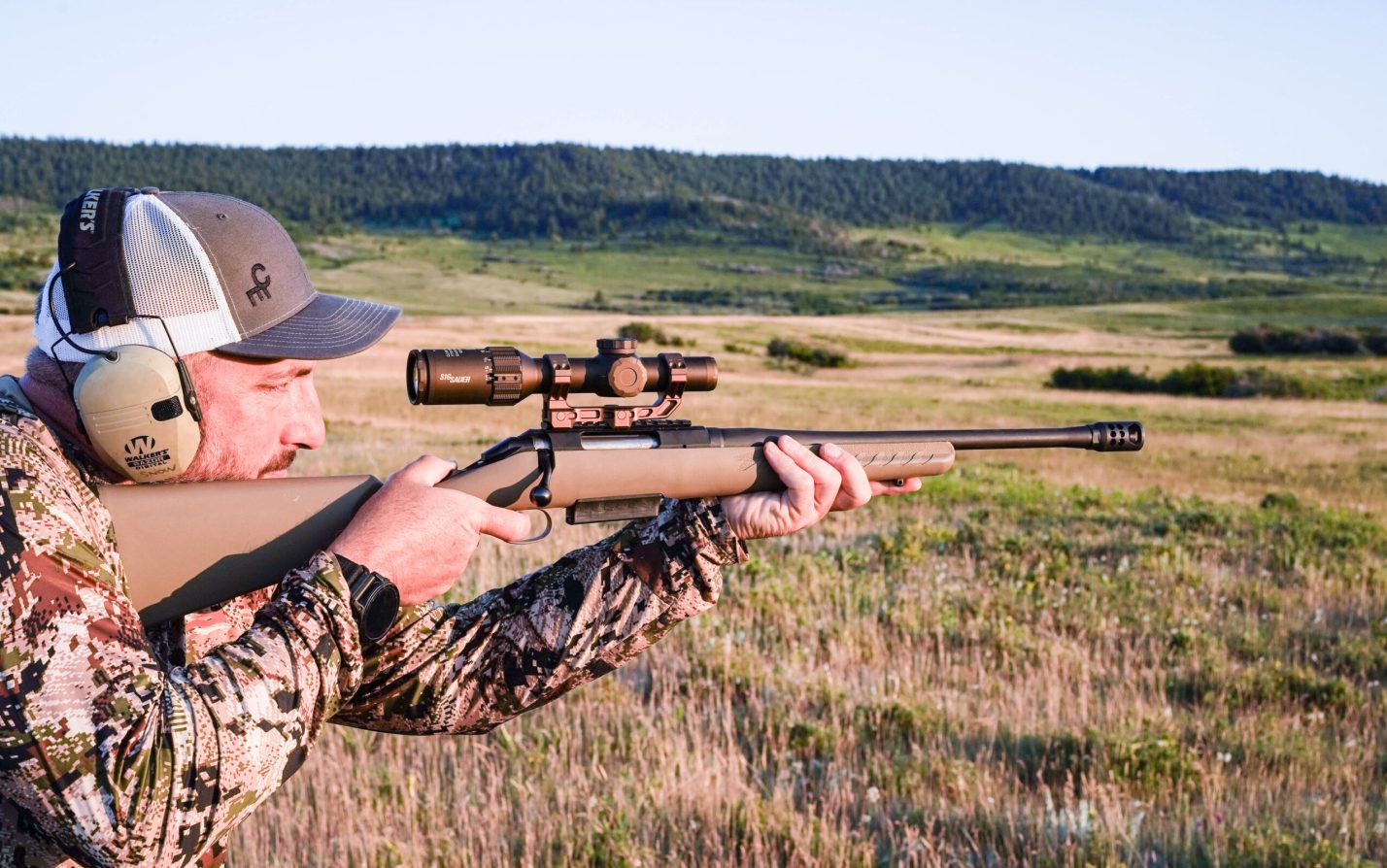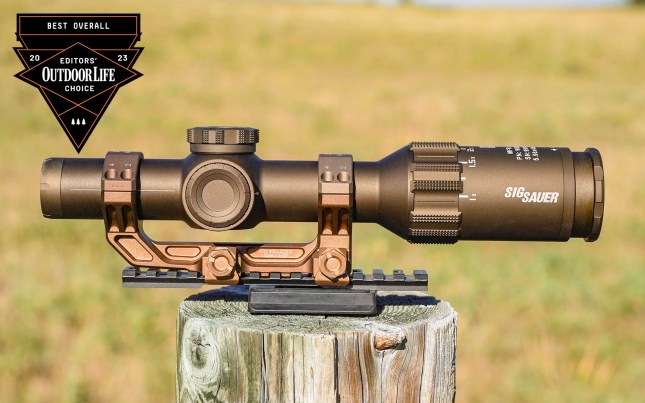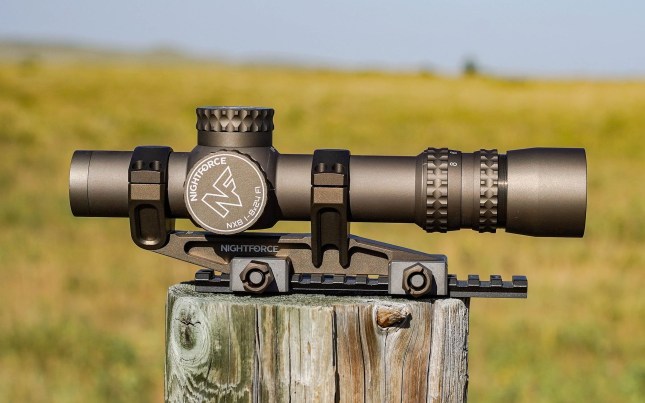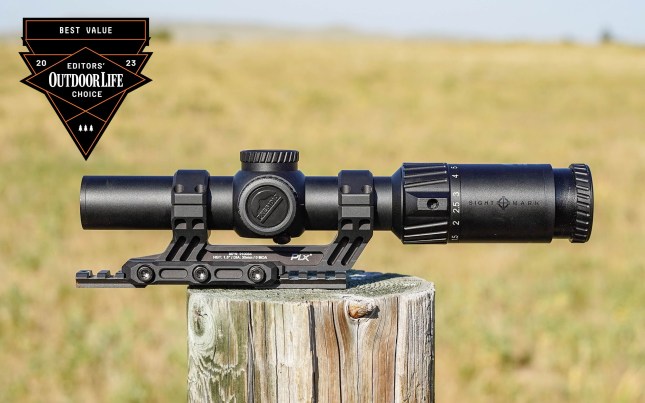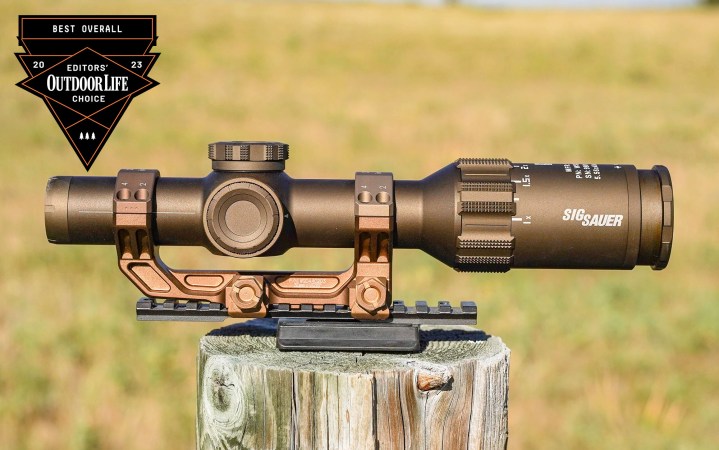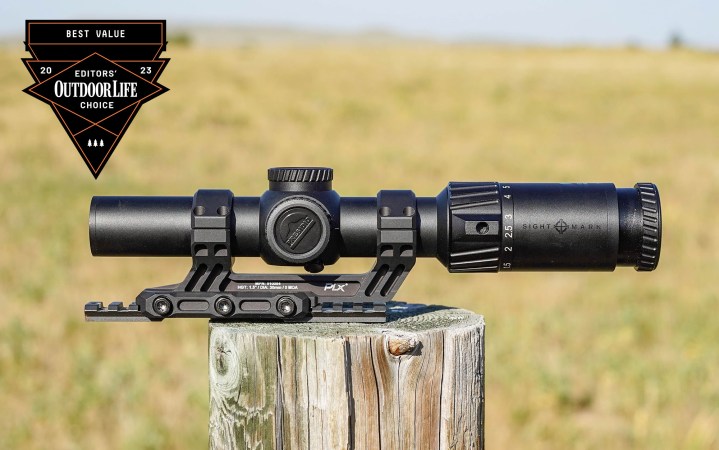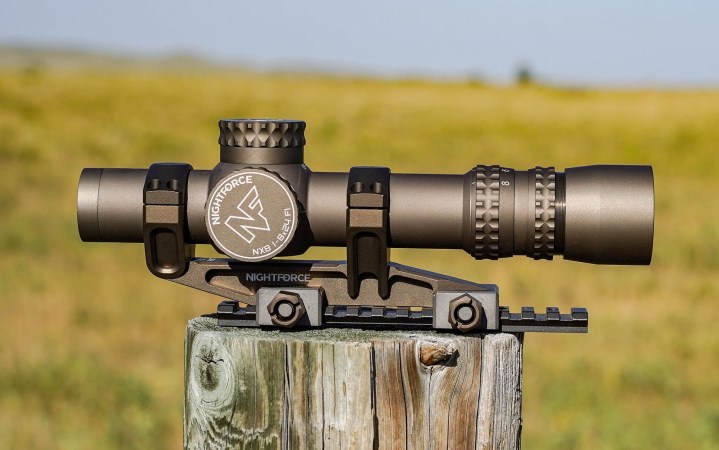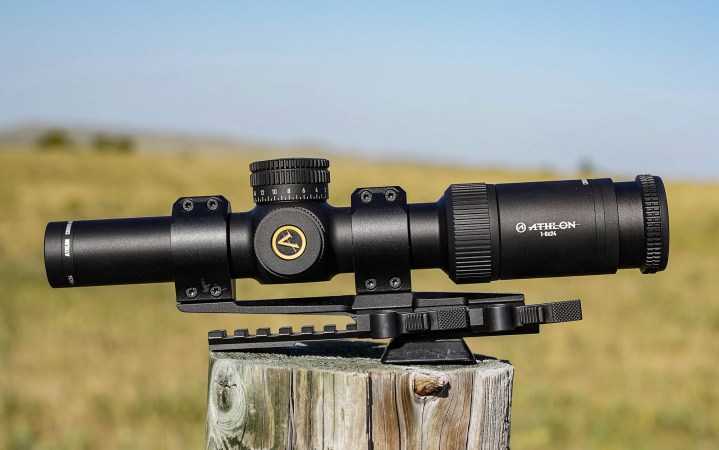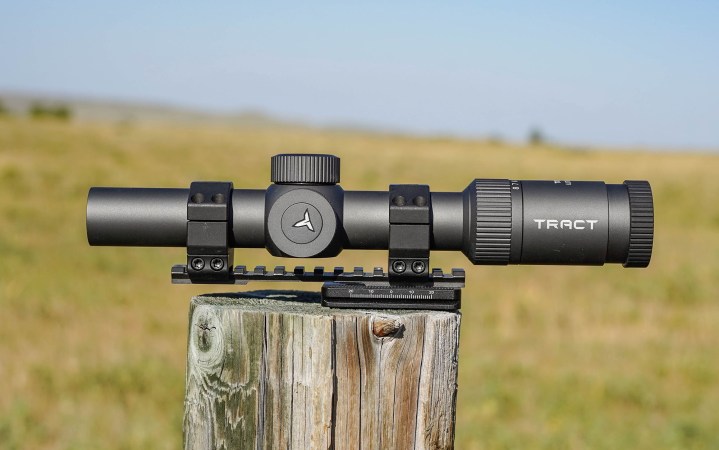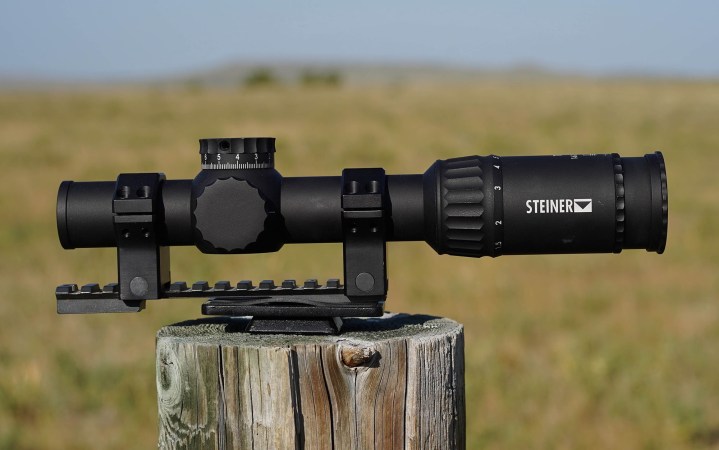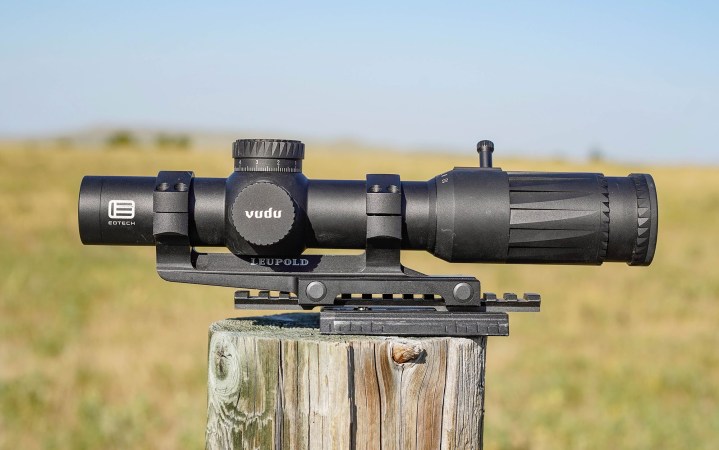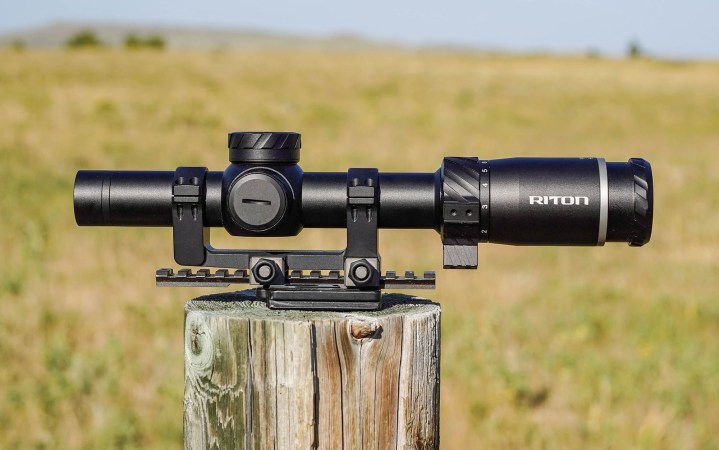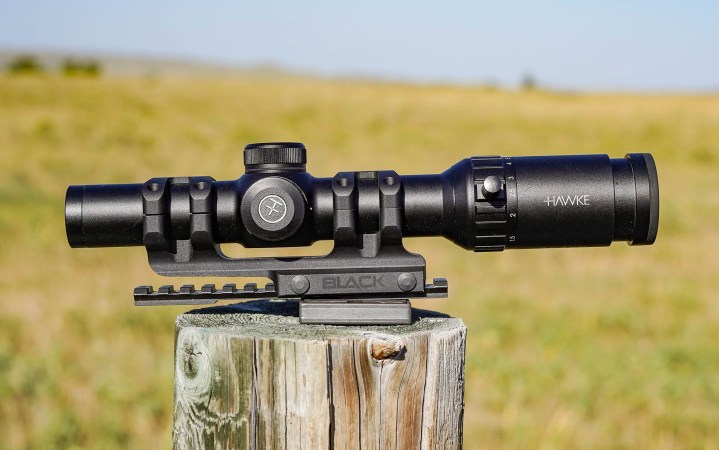We may earn revenue from the products available on this page and participate in affiliate programs. Learn More ›
The rise of AR platforms has driven innovation and market share of the LPVO, sized-down riflescopes that feature low magnification, small objective lenses, and reticles designed for fast shooting in relatively dark conditions.
These scopes sometimes have reticle subtensions that mate up with ballistic parabolas of standard .223 or .308 cartridges, common chamberings for ARs. They typically feature illuminated reticles and capped turrets, the idea being that you’re not dialing, but rather using holdovers in a dynamic situation. Think personal defense, nighttime hog hunting, or competition shooting in which you have to move, adjust, and fire at unknown distances in changeable light conditions, sometimes with the aid of a thermal or night-vision module in tandem with your riflescope.
But a funny thing happened along the way to designing a purpose-built optic: The LPVO became our new versatile riflescope, as useful atop a rimfire plinker as on an AR you might keep in the closet, and extremely well-suited to turkey shotguns and dangerous-game rifles. This category is maturing quickly, with the significant evolution of dual-purpose first-plane reticles, and this year we saw appealing growth in illumination systems, turret operation, and reticles designed for close-quarters engagement and far-off precision.
We received nearly 20 LPVO scopes for this year’s test, a mix of new introductions and models on the market for a year or two. From those submissions, we whittled the field down to 10 that represent a cross-section of designs, intended uses, and prices. We hope our test results are a useful buyers’ guide for shooters looking to invest in this ascendant species of optic.
- Best Overall: Sig Sauer TANGO6T 1-6×24
- Best Value: Sightmark Presidio 1-6×24
- Best for Competition: Nightforce NX8 1-8×24
- Best for 3-Gun: Athlon Cronus BTR Gen2 UHD 1-6×24
- Best Dangerous Game Scope: Tract Toric UHD 1-8×24
- Steiner T6Xi 1-6×24
- Trijicon Credo HX 1-8×28
- EOTech Vudu 1-10×28
- Riton 5 TACTIX 1-10×24
- Hawke Vantage 30 WA FD IR 1-8×24
How We Tested the Best LPVO Scopes
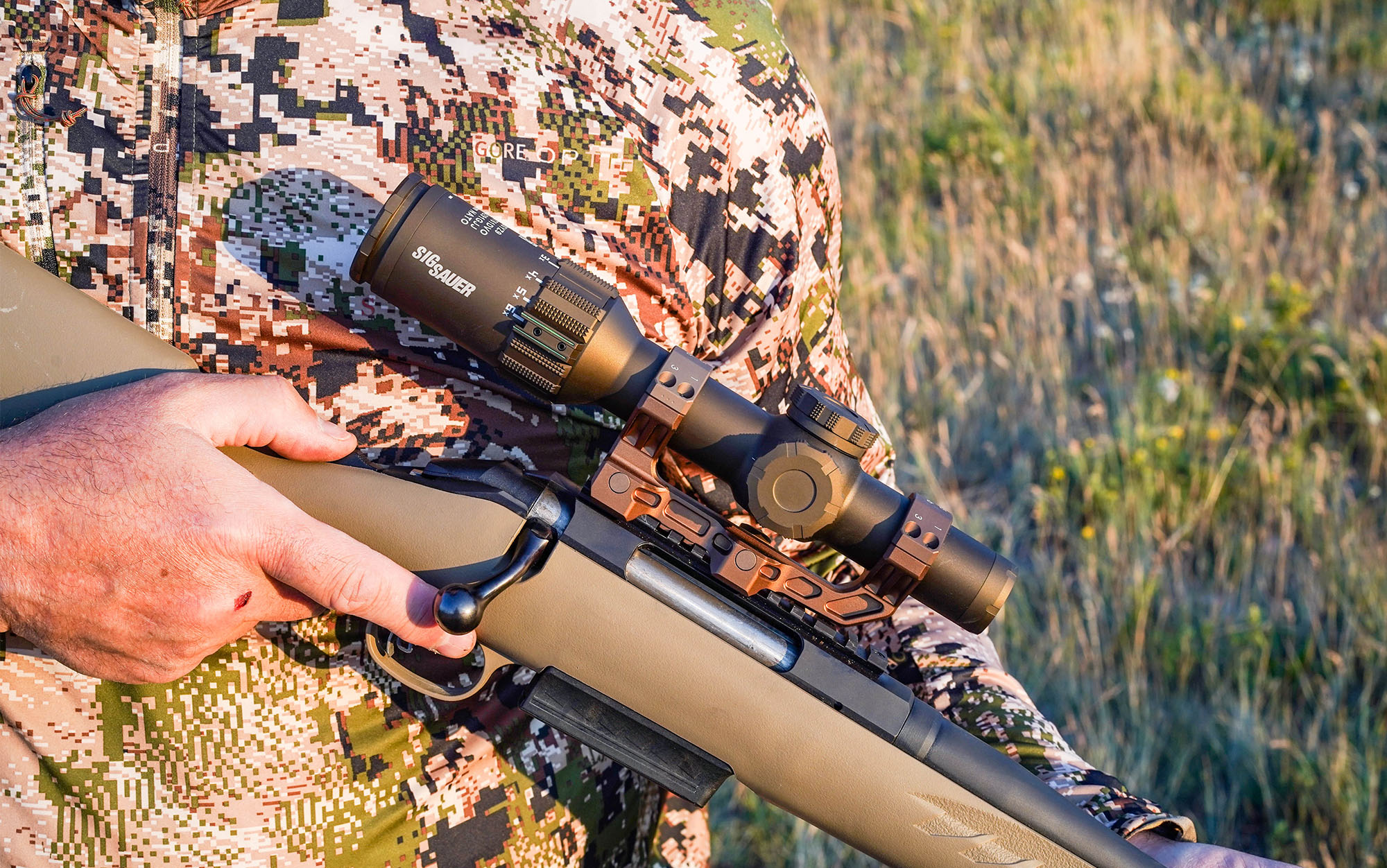
Just as our test has evolved to evaluate rifle scopes on a different basis than we judge spotting scopes and binoculars because their job as projectile-placement instruments is categorically different from image magnifying and clarifying optics, we test LPVOs differently than precision scopes.
We gave slightly less emphasis to turret feedback, for instance, than reticle illumination. And we rewarded reticle versatility of an LPVO slightly more than we do optical quality, the idea being that these aren’t observational instruments so much as bullet-placement devices.
Because ours is a test of brand-new along with venerated veteran LPVOs, we used a couple of models that we consider the Platonic ideal of the platform for the basis of comparison. For higher-end competition scopes, we used both the Nightforce ATACR 1-8×24 F1 and Vortex’s Razor HD Gen III 1-10×24 as our basis of comparison. For all-around AR/dangerous game/turkey optics, we used Leupold’s excellent Patrol 6HD as the benchmark. And to compare price-point LPVOs, we used the AR Optics 1-6×24 from Bushnell to assess the attributes and performance shooters can expect from a scope priced under $300.
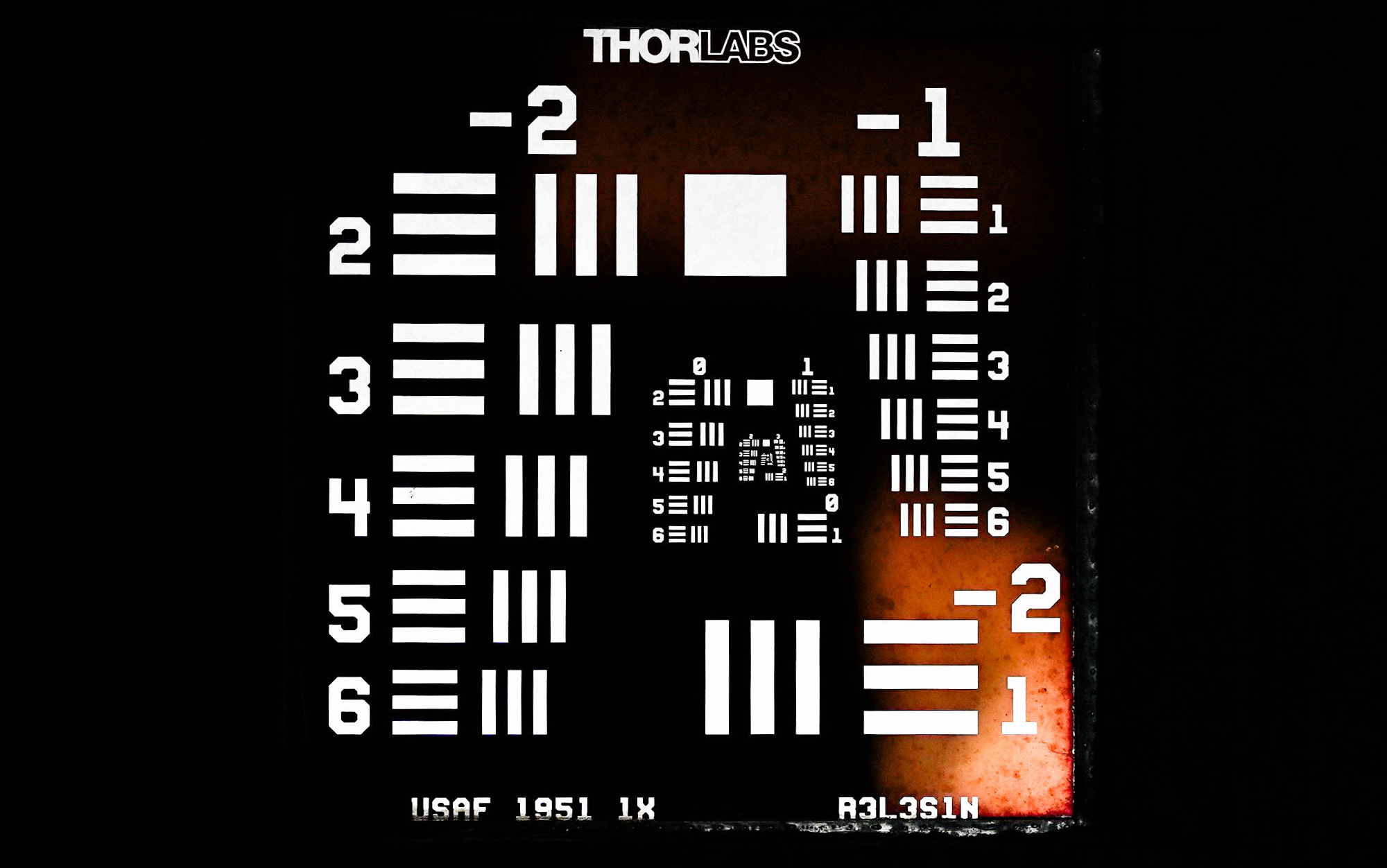
Just as with our other Optics Test categories, we put all submissions through the same criteria. First, we measure optical resolution, using the diminishing black-and-white lines of a 1951 Air Force Resolution Target to score the optical performance of each submission. We also measure the low-light performance of each LPVO scope by mounting them to tripods and focusing them as a group at 200 yards at a black-and-white resolution target at twilight, all in order to measure the brightness of the glass. As we discussed, neither resolution nor low-light performance are deal-breakers for this category, but both criteria provide valuable insights into the optical performance of the scope.
Then we take each submission to the shooting range. We put each LPVO through the same regimen of accuracy testing on bullseye targets, tracking, and return-to-zero assessment on a 10-minute grid, but we spent relatively more time on shooting drills to assess their combination of instinctive aiming, precision, and versatility. These included rapid target transition drills from standing, seated, and prone positions, followed by a big-bore instinctive shooting drill in which we walked a target course of steel plates positioned anywhere from 20 to 70 yards, and when a referee blew a whistle, the shooter had to find and hit a target within 5 seconds.
We break our 10-point scoring into four general categories:
- Optical performance (15 percent of total grade)
- Aiming system (a whopping 60 percent of total grade)
- Design (15 percent)
- Value (10 percent)
The average of these categories is the basis of our grades, detailed below.
Optical performance includes the resolution and low-light tests plus the more subjective assessments of image quality and brightness. Aiming-system performance assesses interior (reticle design, visibility, and utility as well as illumination) and exterior aiming system (turret positivity and indexing, parallax adjustment, zero stop), precision, and shootability. Design considers the exterior finish, interior blacking, mounting dimensions, and durability.
And then our price/value score rates how much scope—along with warranty and amenities such as rings, extra turrets, and lens covers—you get for your money. The LPVO that gets the highest overall score wins our editor’s choice award for the best in the category; the optic with the highest price/value score wins our Great Buy recognition, and we give other awards based on specific attributes.
How We Grade LPVO Riflescopes
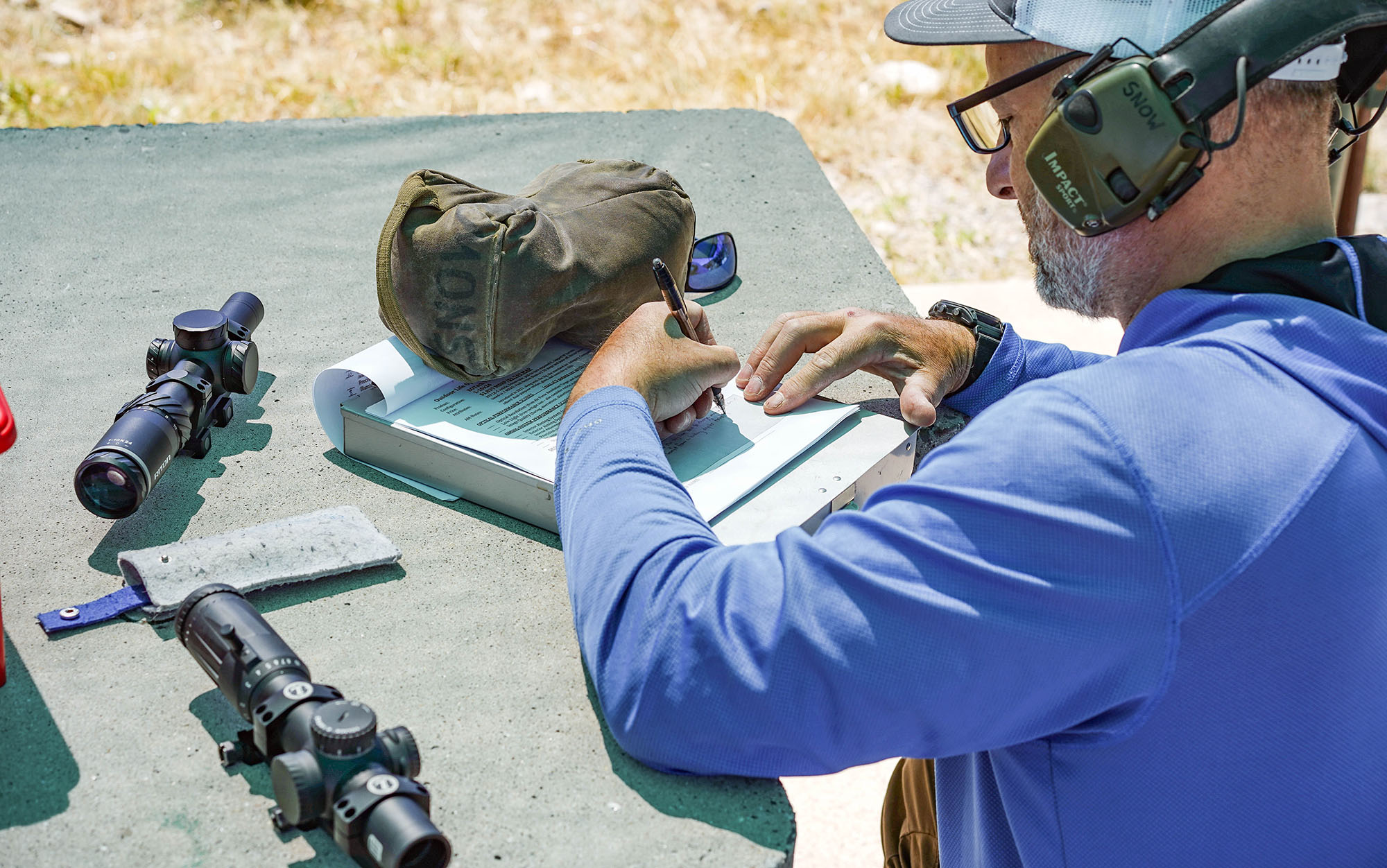
Our 100-point evaluation adds up to a total numeric score, but we translate those to grades for each submission. Our optical performance grade combines the scores from resolution, low-light, and image quality. Our aiming system performance grade aggregates the interior/exterior aiming system, precision, and shootability scores. The design grade considers construction, innovation, versatility, and durability. And then the price/value grade is our good-deal grade.
To earn an “excellent grade,” the average of that category must be 9 or higher, which is extremely hard to achieve. “very good” is an average score of 7 to 9. A “good” grade is 5 to 7. Our “fair” grade is 3 to 25, and “poor” is anything under 3.
Best LPVO Riflescopes: Reviews & Recommendations
Best Overall: Sig Sauer TANGO6T 1-6×24
Score Card
- Optical Performance: Good
- Aiming System: Very Good
- Design: Very Good
- Price/Value: Good
Key Features
- First-plane Hellfire DWLR-556 reticle
- Inverted horseshoe reticle tuned to 5.56 ballistics
- 30mm tube
- Pull-to-turn illumination
- Capped turrets tuned to .2 MRAD click values
- 31 MRAD total internal adjustment
- Parallax fixed at 300 meters
Pros
- Battle-proven design
- Ships with ALPHA4 cantilever mount
- 11-step illumination (nine daylight, two night-vision)
- Good glass
- Liberal mounting dimensions
- Flat dark earth color
- Mounting line on side of tube reduces cant
Cons
- Reticle utility is limited
- At lowest power, the reticle is hard to see
- At over $1,700 street price, an expensive scope
The Sig TANGO6T was not a runaway favorite, and its fairly limited utility made it one of the least likely scopes to win what is ultimately a test of versatility.
But this tight and bright scope stacked up points by doing a number of things pretty well, and it’s a testament to that niche reticle—its drops are tuned to the ballistic parabola of a 5.56 NATO bullet with a muzzle velocity of 3,210 fps in a 24-inch barrel—that testers recommended it for a dangerous-game rifle, a lever gun, and since the test, it’s found a home on my .450 Bushmaster.
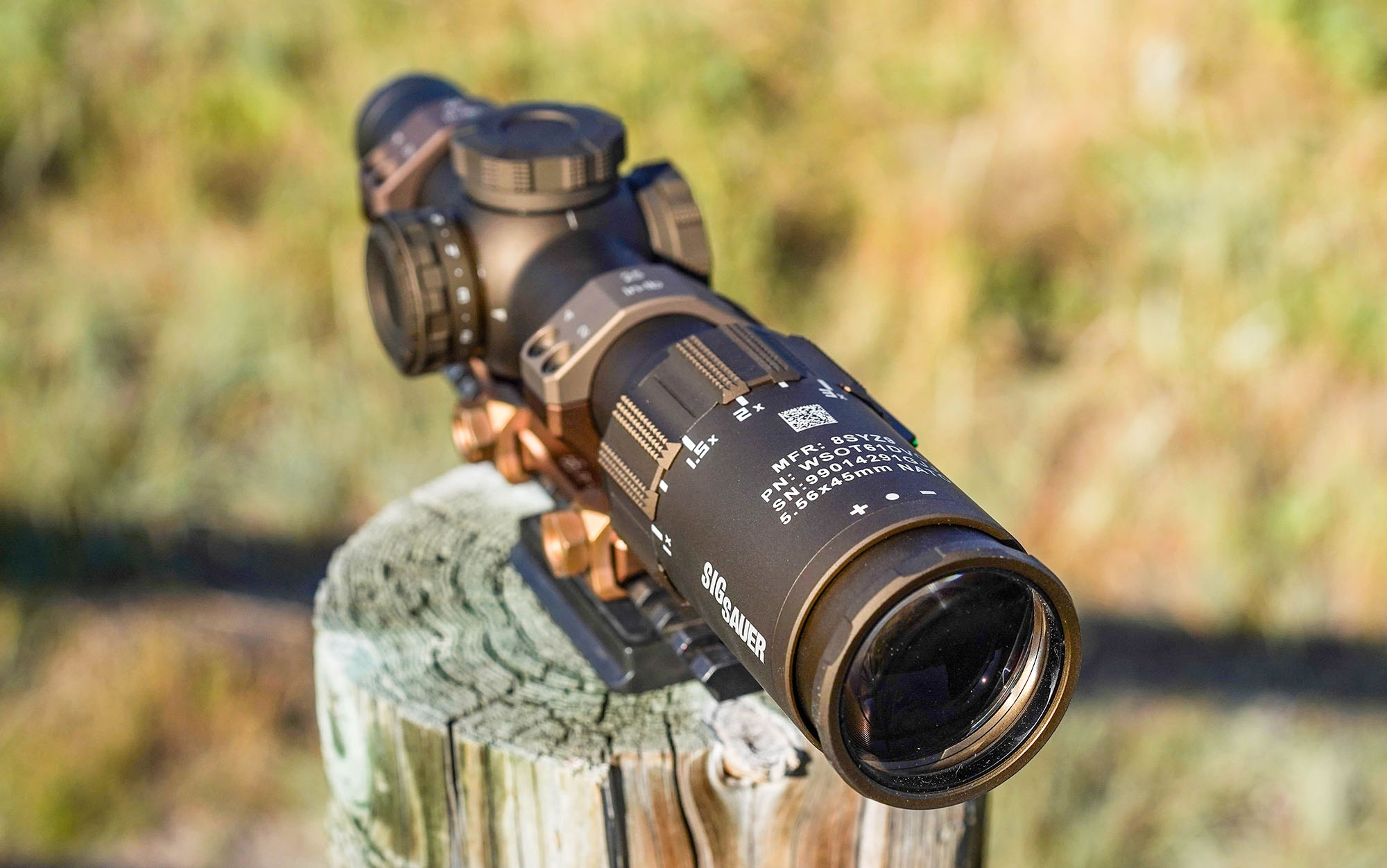
We liked its oversized controls and their movement. The big, grippy power-changing ring is easy to manipulate with gloved hands. The capped turrets turn with authority, thanks to their oversized diameter. And the illumination control turns with positivity, and turns off between intensity levels. We also liked the indexing on the scope. The zero indication is easy to see, the power-changing ring has half-magnification hashes to further aid in precision. And the white mounting line on the outside of the flat dark earth tube is a simple and smart aid to ensure that you don’t introduce cant to the scope as you position it in rings. We wish more brands would employ this feature.
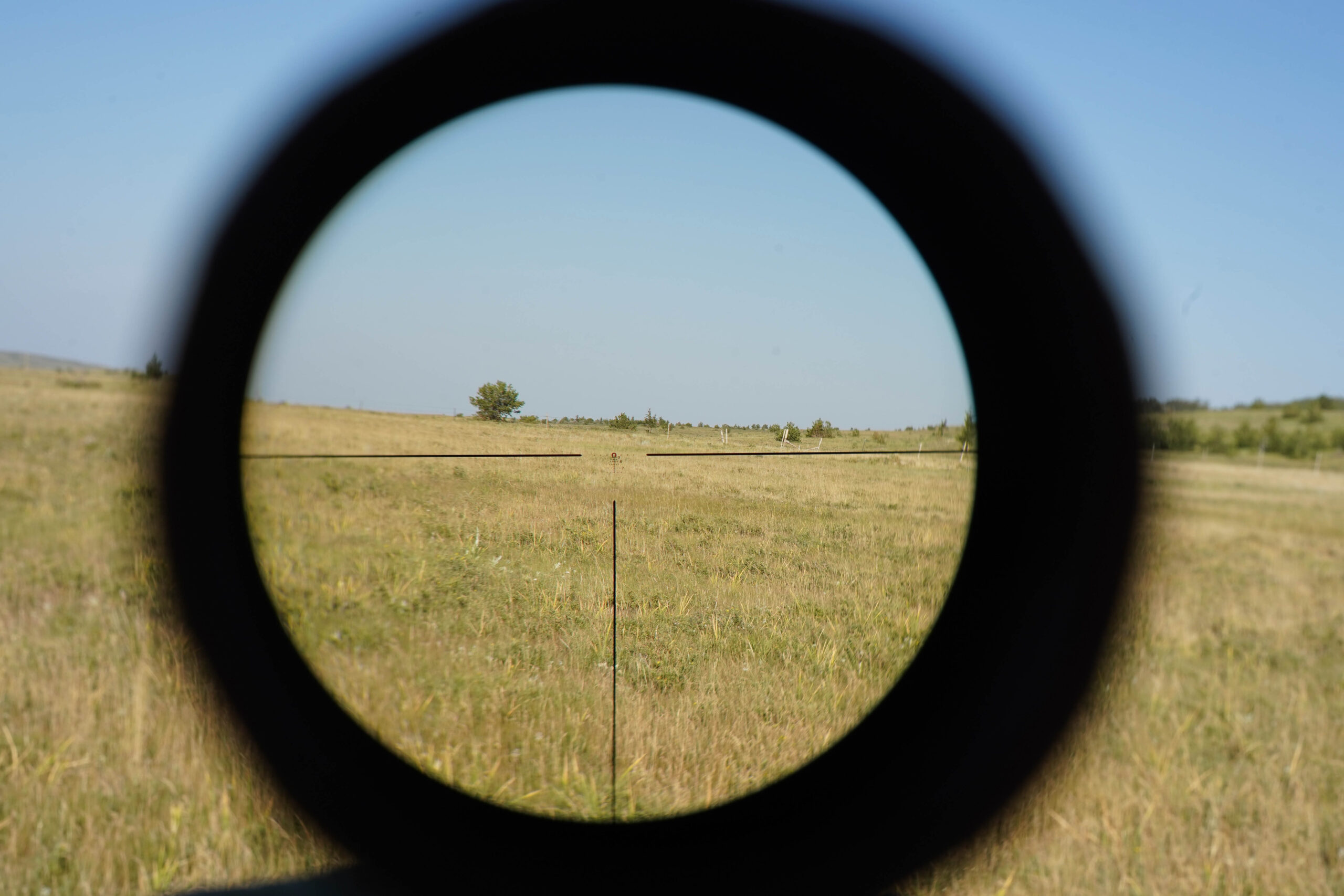
The class of Japanese glass that Sig uses in this scope is good, which made us wonder why the TANGO6 received lower-than-expected resolution and low-light scores. The scope made up ground with high construction, durability, and design scores. We recognize that the TANGO6T is the civilian version of a scope that has served the U.S. military branches as their preferred Direct View Optic. That category requires a minimum magnification of 1X with no rounding (or fisheye distortion) and a maximum magnification of 6X.
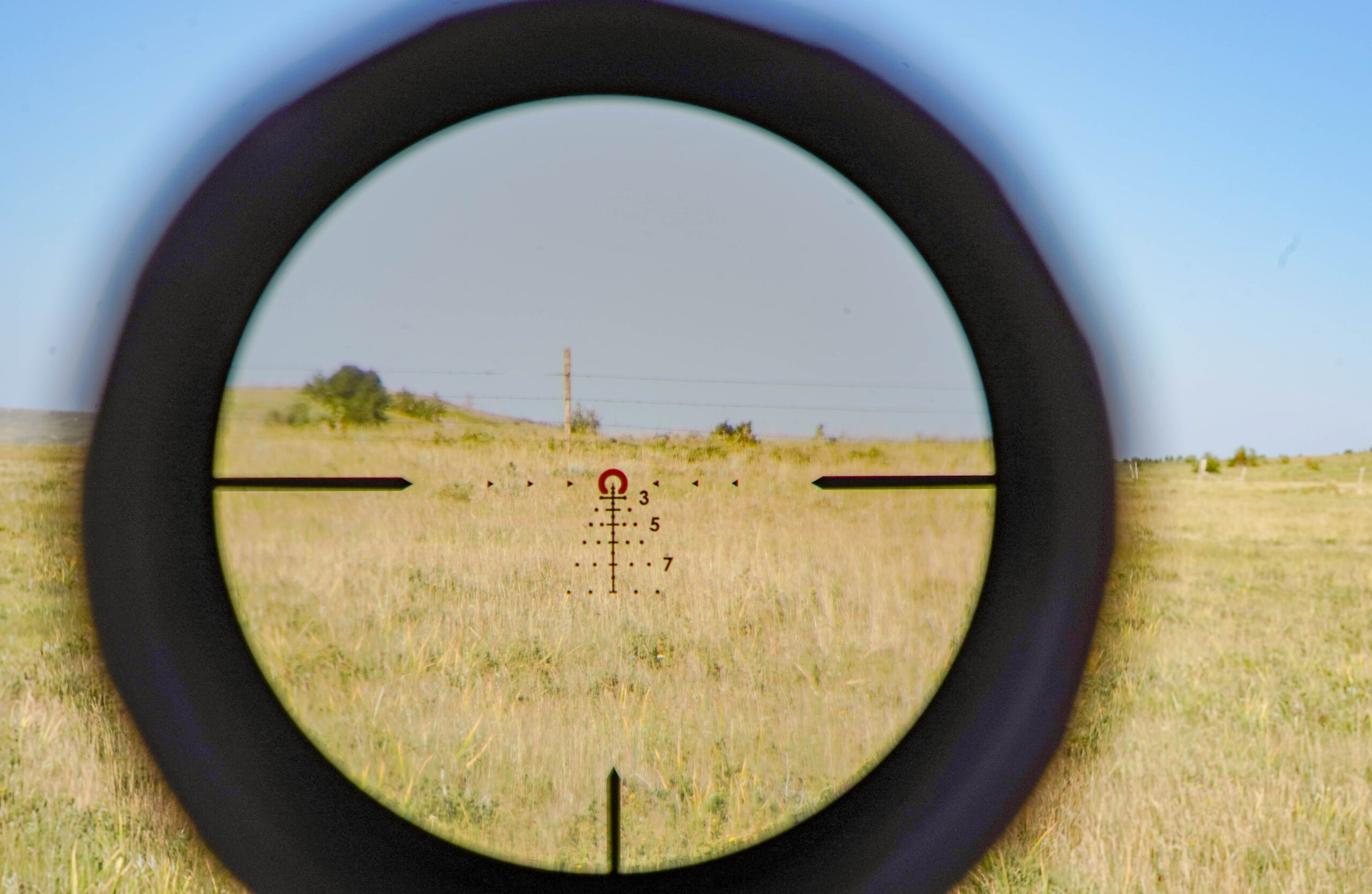
The inverted horseshoe Hellfire DWLR performs as an illuminated red-dot sight from 1-3.5X, when the first-plane references are too fine to see clearly. But from 4 to 6X, the bullet drops and windage dots are easy to deploy. With a 100-yard zero, the scope gives 5.56 shooters drop values out to 800 yards, with corresponding windage marks for a 10 mph crosswind. Our favorite combination of instinctive shooting and precision is about 4.5X, when the center aiming point provides fast target engagement, the field of view is wide enough to receive peripheral information, and you can still see those precision references.
The Sig was our favorite scope to use in dynamic target transition drills, and it performed very well on our big-bore instinctive shooting range.
The Sig received low price/value marks, largely because its price—it retails for $2,200 and sells for a street price of a little over $1,700)—puts this out of reach of casual shooters. The addition of an excellent cantilever mount and a set of smart lens caps that feature magnets that allow the lids to stow out of the way when the scope is deployed are both nice additions, but don’t change our mind that the TANGO6T is a little overpriced.
If you’re looking for a hard-wearing LPVO for a .223 or 5×56 AR, and you can afford the Sig, this is an excellent choice. But it’s also a fine scope for a wide range of other close-range shooting situations.
Best Value: Sightmark Presidio 1-6×24
Score Card
- Optical Performance: Poor
- Aiming System: Good
- Design: Fair
- Price/Value: Very Good
Key Features
- Second-plane CR1 MOA-based reticle
- 30mm tube
- Six-intensity red illumination
- Parallax fixed at 100 yards
- Capped turrets tuned to .5 MOA click values
- 140 MOA total elevation adjustment
Pros
- At under $300, an affordable LPVO
- Horseshoe/dot BDC reticle is versatile
- Ships with throw lever and lens caps
- Rezeroable turrets
Cons
- Forgettable optics
- Turret indexing is confusing
- Precision capability is limited
This scope will get the job done, especially if the job is ringing steel out to about 300 yards with your AR, and then cleaning plates inside about 100 yards. The second-plane BDC reticle has just enough references to be useful without being distracting, and the illumination blazes at a nicely visible daylight brightness, though its lowest intensity is still too bright for low-light conditions.
But there are sizable jobs this scope won’t get done. Notably, that includes precision distance work. The reticle just doesn’t have enough references to make it effective beyond that 300 mark. It also may give you a headache. The glass was among the least impressive in the field, finishing at the bottom of our low-light test and near the bottom in resolution scores. Testers used terms like “wavy” and “blurry” to describe the edge of the image, and panning at 1X you notice a fish-eye effect, evidence of some pincushion optical aberration. Controls are hard to turn.
But “it’s not a bad optic for the price,” concludes tester and OL’s shooting editor, John B. Snow. “A guy on a budget could do worse.”
Indeed, for under $300 you get a very serviceable LPVO, with a magnification range that will handle everything from personal defense to predator hunting, and ran our dynamic shooting drills without pause. The 6-step illumination is serviceable, and the low-profile rezeroable turrets are decent to dial, though we wish the indexing was more useful.
You might even mount the Presidio on a rimfire or even a turkey gun. That’s a lot of value for a fair price, and the main reason the Sightmark is our Great Buy LPVO scope.
Best Competition: Nightforce NX8 1-8×24
Score Card
- Optical Performance: Fair
- Aiming System: Very Good
- Design: Very Good
- Price/Value: Good
Key Features
- First-plane FC-DMx reticle
- 30mm tube
- Capped turrets tuned to .2 MIL click values
- 30 MRAD total internal adjustment
- Ten-step illumination
Pros
- New capped elevation turret
- Segmented center circle acts as red-dot aiming point
- At higher mags, 1MRAD aiming grid comes into view
- Excellent turret feedback
- Excellent indexing
- Stylish dark earth color
- Battle-worthy durability
Cons
- At over $1,800, a pricey scope
- Difficult to focus inside 100 yards
- Utility limited to precision shooting
The NX8 has been around since 2017, but this version features a number of significant upgrades. First, it has a capped elevation turret, a response to shooters who wanted insurance that elevation adjustments wouldn’t accidentally move during transit or rough handling. Second, it’s offered in a sexy dark earth color in addition to the classic black. But the main change is the availability of the FC-DMx reticle, previously available only in the higher-grade ATACR scope.
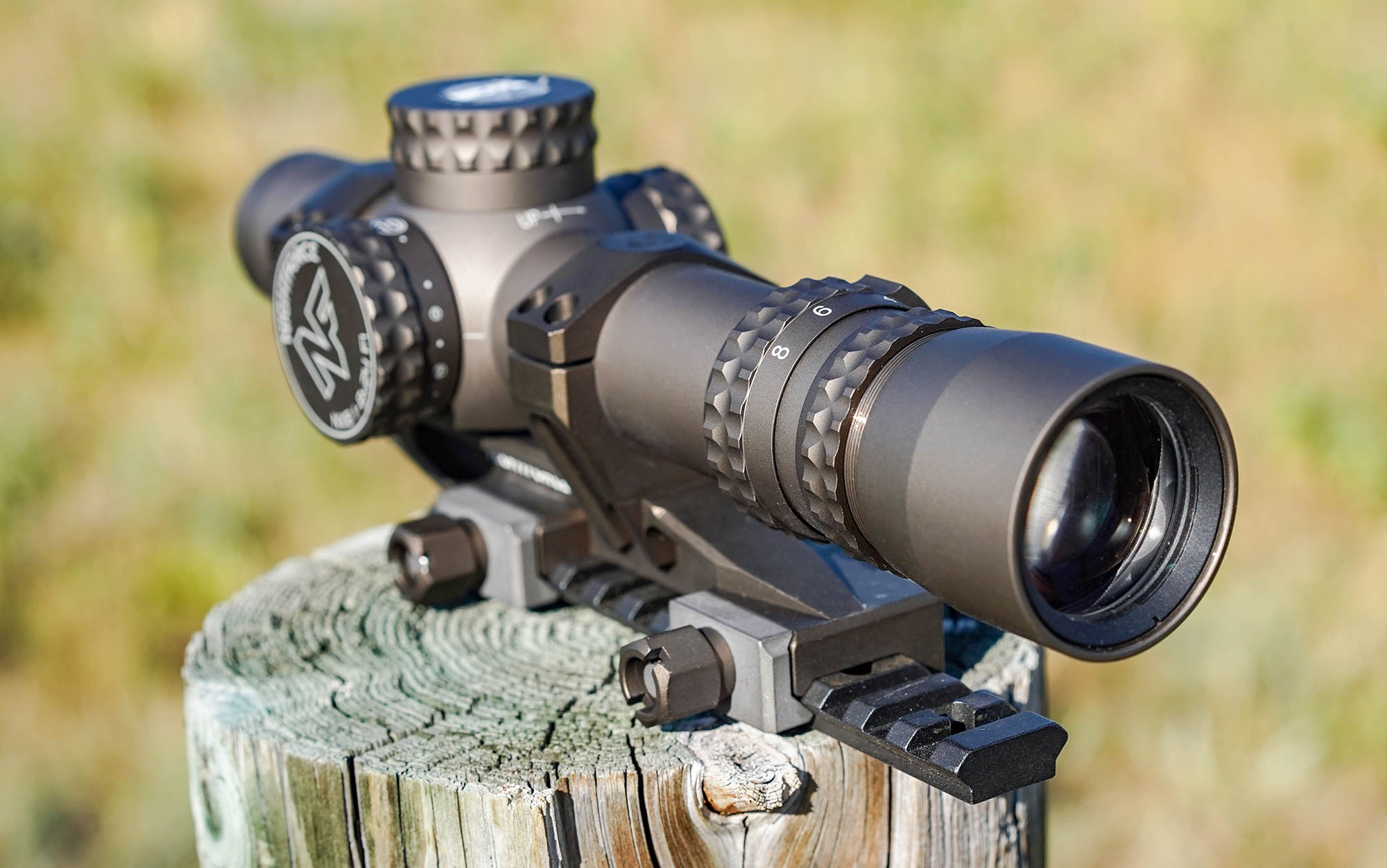
The reticle is worth your attention. It’s the best precision reticle in this category, which is dominated by first-plane reticles that offer fast aiming at low powers and close-enough precision at higher mags. The FC-DMx does both pretty well, but its superpower is offering a mother-ton of aiming points at 6X. The heart of the FC-DMx is a segmented circle that can be blazingly bright with the highest illumination intensity. Still, it really comes into its own at about 4.8X when the aiming grid becomes visible. The 1 MRAD grid allows for 10 MILS of holdover and windage holdoff, and if you want to get really crazy, there are holds for 15 and 20 MILS at the bottom of the field of view.
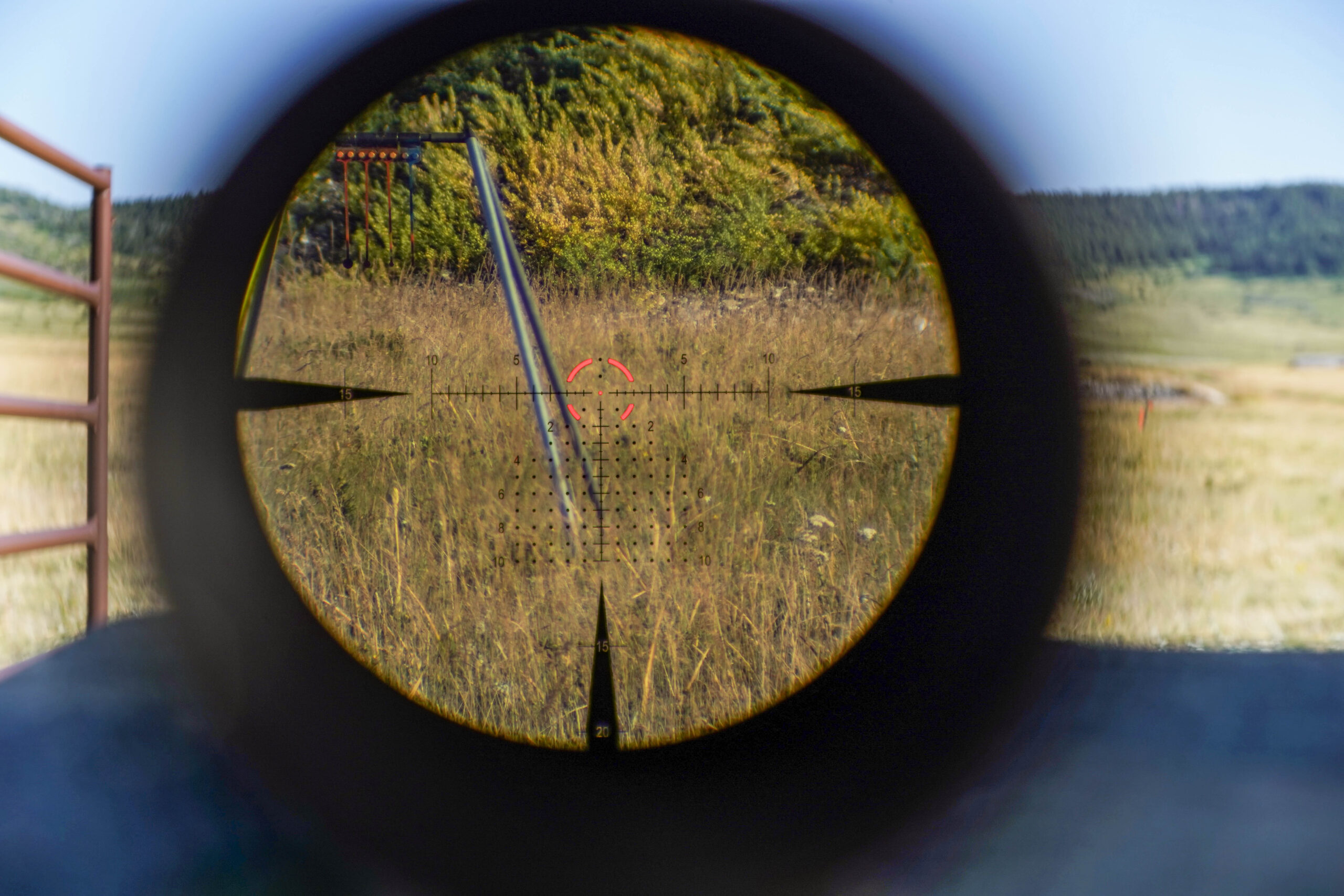
There’s no other LPVO reticle in our test with this level of precision or scale of aiming possibility. The rest of the scope is equally noteworthy. The turrets track with repeatable precision and the turrets are crisp and positive. The illumination control is similarly tactile. Testers liked the Nightforce’s indexing and overall handling, but noted that the magnification knob needs a throw lever because the scope mounts so low to the rifle that it’s hard to grip the dial.

Testers struggled with focusing both the image and the reticle, and felt the NX8 was pretty pricey given its fairly limited utility as a low-power precision scope. But with all that, it’s a great choice if you intend to do much long-range target work with an AR.
Best for 3-Gun: Athlon Cronus BTR Gen2 UHD 1-6×24
Score Card
- Optical Performance: Good
- Aiming System: Good
- Design: Good
- Price/Value: Very Good
Key Features
- Second-plane MOA-based reticle
- 30mm tube
- Pull-to-turn exposed turrets
- Turrets tuned to .5 MOA click values
- 120 MOA total internal adjustment
- 11-step red illumination
Pros
- Easily rezeroable turrets
- Oversized eyebox
- Reticle tuned to ballistics of .223/5.56
- Holdover references to 600 yards
- Good class of glass
Cons
- Second-plane reticle
- Fairly narrow application
This scope caused quite a bit of discussion among testers, mainly over whether the LPVO platform is optimized with a first- or second-plane reticle. While the consensus is that a first-plane reticle boosts versatility (with a reticle in the front focal plane, a scope can serve as both a fast-aiming red-dot and a distance precision rig), the Athlon makes a good case for the utility of a second-plane reticle.
In the case of the Cronus BTR, the reticle is optimized for 3-gun competition, allowing shooters to engage targets at close range with the illuminated center dot, but at the highest magnification, the reticle guides .223 rounds out to 600 yards, with a 200-yard zero. It’s a smart, simple, very effective design that’s in keeping with the good manners of this scope.
The Cronus BTR scored near the top of our resolution test, a testament to its very good glass. It didn’t bring much game to the low-light test, but overall testers thought the image was very good for the configuration. Testers also liked the positive zero stop, the clear and bold indexing on the turrets, and both the illumination dial operation and the crisp illuminated center dot that shredded the dynamic target transition drill.
We’d like to see the power-changing ring have bolder indexing, and increase magnification to at least 8-power to better see distant targets, but overall this is a very useful scope for competition shooters and anyone who wants quality components in a short-range optic.
Best Dangerous Game Scope: Tract Toric UHD 1-8×24
Score Card
- Optical Performance: Very Good
- Aiming System: Good
- Design: Good
- Price/Value: Fair
Key Features
- Second-plane MOA-based reticle
- Ten-step center-dot illumination
- 30mm tube
- Capped platter-style turrets tuned to .5 MOA click values
- Hash-style reticle
- 100 MOA (30 MRAD) elevation adjustment range
- Distinctive graphite finish
Pros
- Liberal mounting dimensions
- Excellent optics
- Velvety controls
- At 20 ounces and 11 inches, a light, compact scope
- Wide range of utility, from rimfire to big-bore rifles
- Tool-less rezeroable turret
Cons
- Reticle references are confusing
- Limited precision capability
- Turret indexing is hard to read
This scope demonstrates the wide versatility of the LPVO platform, while simultaneously proving the limitations for some very specific shooting situations. The second-plane hash reticle has references on the vertical and horizontal stadia, which experienced shooters can use for rimfire plinking, for quick short-range drills, and for slow-fire shooting at distance. We tested an MOA version of this scope; it’s also available in MRAD. Both cost just shy of $1,000.
But because the reticle has no holdoff references for wind adjustments at distance, and because its MOA references are useful at the highest power, this doesn’t bring much to the long-range precision game. That’s OK, because it’s intended to be a fast, simple scope that brings the best 1-power game of all our submissions and has the smoothest, most pleasing controls of the test.
The center-dot illumination is key to the Toric’s appeal. At the highest intensity, the dot (it looks to be about .5 MOA in diameter) offers a bright aiming point that draws your eye to the target. It’s especially quick and intuitive at 1-power, anchoring a huge, bright image that almost appears like you’re not looking through a scope, at all. The Tract’s controls are noteworthy. From the power-changing dial to the turrets and illumination adjustment, all moving parts have the same mellifluous precision.
The Toric scored right in the middle of the pack in terms of low-light performance and optical resolution. For a second-plane design, the reticle received decent marks, though testers questioned the milling hashes. The stadia has marks at 4, 8, and 10 MOA, with 40 MOA of elevation holds. The team thought a more intuitive demarcation would be to have either 5 or 2.5 MOA hashes in order to conform to a base-10 alignment. The other aiming-system quibble we had was the tiny, hard-to-read indexing on the low-profile turrets.
The Tract handled our precision and dynamic target transition drills with grace and talent. But the scope really came into its own during our close-range big-bore work. At 1X to 3X, the scope comes to the eye in a snap and the daylight-bright illumination finds the target like a guided laser. This rapid target acquisition talent, combined with a solid build and simple operation makes the Tract our choice for a dangerous-game rifle, when shots are expected to be both point-blank and at moderate distances.
Steiner T6Xi 1-6×24
Score Card
- Optical Performance: Good
- Aiming System: Good
- Design: Very Good
- Price/Value: Good
Key Features
- First-plane KC-1 reticle
- 11-step illumination
- 30mm tube
- Exposed elevation, capped windage turrets
- Turrets tuned to .1 MRAD click values
- Includes throw lever
Pros
- Rapid-acquisition reticle at low powers
- Decent precision detail at high powers
- Illumination includes four night-vision settings
- High-contrast white indexing on matte-black finish
- Second revolution turret indicator
Cons
- Grit in magnification dial
- Reticle could use reference numbers
The excellent Steiner T6Xi is the third (of several) LPVOs that cost close to $2,000 and feature attributes that were either designed for or have been informed by military use. That lineage is part of what makes this platform so rugged and intuitive for tasks like sweeping houses for bad guys or for engaging mid-distance targets with your duty weapon.
But it’s fair to ask how much of that sort of work you’ll be doing with a civilian LPVO. It seems more likely that you’ll be cleaning plates in close-range rapid-fire drills and then slowing things down and picking off targets out to 300 yards. Or impressing your buddies by shooting the eyes out of Halloween pumpkins at 25 yards and then ringing a 400-yard gong out in the pasture. Given that end use, do you really need a high-end optic on a gun you’re unlikely to stretch beyond that range?
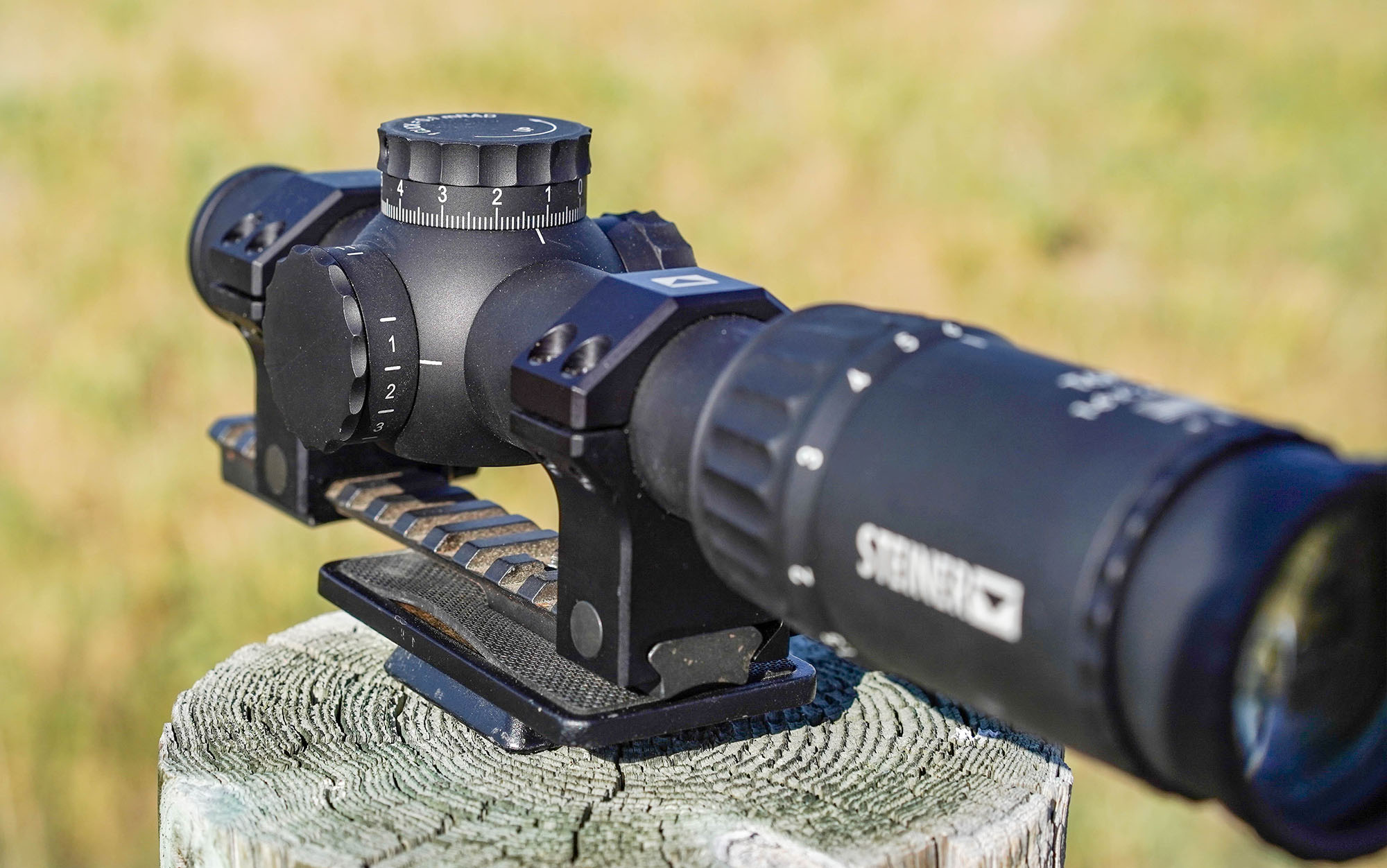
That’s a question only you can answer. The good news is that the Steiner—along with the Sig and the Nightforce—can handle just about any work you throw at it. The T6Xi has incorporated many attributes Steiner has perfected on martial scopes: precise and durable turrets, a wonderful range of illumination, and a reticle that can handle just about any shooting situation.
The Steiner scored slightly better than its two peers on low-light and resolution evaluations, and the team felt that the T6Xi was the best of the class to dial to a longer-range aiming solution. The reticle, designed by the folks from Kinetic Consulting, features a bold illuminated outer circle with an illuminated segmented circle center aiming point. It’s a fast, intuitive system that leads the eye to the target in any light conditions. As you ramp up the magnification, the outer circle disappears, and you have hash-style elevation and windage holds to guide distant shots.
It’s a classic patrol-style reticle rendered well, and is a member of a wider family of scopes, made in Colorado by the German brand. The T6Xi line includes a 2.5-15×50, 3-18×56, and 5-30×56. Given Steiner’s excellent transferable lifetime warranty, the family’s durability has ample backing, whether you bought the scope or not.
The reticle in the 1-6 version could be even more useful if it had a couple numeric markings to guide shooters, so they don’t have to count hashes to get the proper hold. For the price, we also wanted a slightly smoother power-changing control. But those are very minor quibbles to improve an otherwise extremely handsome, capable, and versatile low-power scope.
Trijicon Credo HX 1-8×28
Score Card
- Optical Performance: Good
- Aiming System: Very Good
- Design: Good
- Price/Value: Good
Key Features
- First-plane MOA Segmented Circle reticle
- 34mm tube
- 12-step red and green illumination
- Exposed pull-to-turn turrets tuned to .25 MOA click values
- Turrets are both rezeroable and zero-stoppable
- 100 MOA total internal adjustment
Pros
- Larger objective lens than peers
- Segmented-circle reticle good fast-acquisition design
- At higher powers, MOA hash references guide shots
- Heavy and durable
Cons
- At 25.6 ounces, one of the heaviest LPVOs
- Poor edge clarity
- Must zoom to 4X to utilize center crosshair
Another of the high-end LPVOs, the Trijicon is equally at home with close-range pointing or longer-range precision shooting. It’s also agnostic about holding or dialing for aiming solutions. In all, this is a lot of scope, from the physical heft of the 34mm tube and 25.6-ounce weight to the wide capabilities that it offers shooters.
Unlike its premium peers, the Credo HX wowed us optically. The scope won our resolution evaluation, and performed near the top of the middle of the class in terms of low-light performance. We expected the 28mm objective lens to pull a little more weight than its 24mm peers, but there’s nothing wrong with the glass or optical prescription.
Testers loved the velvety controls and assured handling of the Credo. The pull-to-turn turrets, governed by .25 MOA click values, move with assurance. We loved the clear turret indexing and revolution indicators, and the illumination, in both red and green, makes the reticle pop in just about any light condition.
Testers liked the fast-pointing reticle at lower powers. From 1X to about 4X, the big illuminated circle guides the eye to the smaller segmented circle aiming point. At higher powers, shooters can use the MOA hashes to determine holdovers and hold-offs. The reticle features 100 MOA of hold to the lower post.
Testers liked the easily rezeroable turrets—simply unscrew a retaining cap, lift the turret, and reposition it to the new zero, then cinch down the cap. The Trijicon’s turrets also have a hefty zero stop.
“This feels like driving a Cadillac after shooting the lower-end scopes, which shoot the way a Kia drives,” said one tester, who appreciated the fluid movement of the Trijicon’s controls. At a real-world price just under $1,300, it’s a little more accessible than its peers, but the Credo HX has plenty of talent for just about any shooting situation or platform.
EOTech Vudu 1-10×28
Score Card
- Optical Performance: Good
- Aiming System: Good
- Design: Good
- Price/Value: Fair
Key Features
- First-plane LE-5 reticle
- 34mm tube
- Pull-to-turn exposed elevation turret, capped windage
- Turrets tuned to .1 MRAD click values
- Ten-step push-button illumination
- Removable throw lever
- 29 MRAD elevation, 23 MRAD windage adjustment
Pros
- Battle-proven design
- Dual-purpose reticle
- Rezeroable turrets
- Available in three reticle styles
Cons
- Diopter moves with magnification change
- Sloppy elevation turret
When this 1-10×28, first-plane version of the venerable Vudu was introduced by EOTech in 2021, we raved over its versatile reticle and bombproof build. Those remain noteworthy attributes, but it’s a testament to the optics industry that the Vudu is no longer singularly remarkable. It’s one of a series of very good LPVOs that can handle close-in engagement and way-far precision shooting, but as the sea level has continued to rise for this category, the Vudu is no longer at the wave’s crest.
Its shortcomings are fixable. It lost points on design because testers who instinctively grabbed the eyepiece to change power routinely unfocused the reticle as they ramped up and down the magnification. A locking diopter ring would solve this problem, in which either the reticle went out of focus or the magnification changed as shooters tried to true the reticle. The pull-to-turn elevation turret is a great idea, but after a full day of shooting—and dialing—we noticed quite a bit of slop in the entire turret assembly.
The heart of the scope is its very interesting and useful first-plane reticle. Our sample had the LE-5 MRAD design, with an illuminated center cross inside an illuminated circle. The scope is also available in the SR-5 MRAD version, with a floating dot inside the illuminated circle, or the SR-4 MOA reticle, with the same dot/circle aiming point and a hashmarked vertical and horizontal cross.
It’s tempting to call this a dual-use reticle, but it’s really a three-way reticle. From 1X to about 4X, the center circle (EOTech calls this their “Speed Ring”) and outer circle guide your eye to the aiming point. The illumination intensifies from a barely visible low-light mode to blazingly bright in daylight. At 5.5X, that outer circle conforms to the edge of the field of view, further funneling your vision to the aiming point, allowing shooters to engage close and mid-distance targets. At magnifications above 6X, the reticle expands to reveal the tree-style reticle’s windage and elevation holds, and the scope becomes a very capable precision optics. Both the LE-5 and SR-5 reticles have 12 MRAD of elevation and 6 MRAD of windage references on either side of the Speed Ring; the SR-4 has 40 MOA of elevation holds.
The illumination module features a push-button activation, and additional buttons to increase and decrease intensity. Most of the team liked the design, though tester Mark Copenhaver routinely bumped the buttons, inadvertently (and distractingly) changing the illumination intensity. We also had a hard time focusing the image inside 50 yards, which will limit the utility of this scope for rimfire competition.
The Vudu settled in the very middle of the LPVO pack in terms of optical performance, but scored high on our “shootability” assessment, which is a subjective rating of how well the optic performs on a wide range of field tests. That confirms our original sense that the EOTech is an elite scope with a price (a real-world street price of around $1,700) to match.
Riton 5 TACTIX 1-10×24
Score Card
- Optical Performance: Poor
- Aiming System: Good
- Design: Fair
- Price/Value: Fair
Key Features
- First-plane 30T MRAD reticle
- 30mm tube
- Six-step red illumination
- Capped and rezeroable turrets tuned to .1 MRAD click values
- 40 MRAD internal elevation adjustment
- Airgun safe
Pros
- Ships with multi-position, multi-height throw lever
- Overbuilt steel erector system
- Liberal mounting dimensions
- Easy-turning platter-sized turrets
Cons
- Fairly expensive for performance
- Finicky eyebox
- Internal flaring with most intense illumination
This scope is very close to being a superstar. The 1-10-power magnification range is extremely useful for a wide range of shooting situations. The MIL-based first-plane reticle has three tapered posts that lead the eye to a central aiming point. The architecture aids fast target acquisition at lower magnifications, and a tree-style precision reticle with small and large aiming dots guides bullets at higher magnifications.
Riton calls the reticle their 30T, and shooters can use it to hold 11 MILS of elevation and 11 MILS of windage on either side of a .2 MIL center dot inside a segmented circle, both illuminated. If you don’t care to hold, you can dial with nicely configured low-profile turrets.
But our test is designed to tease out shortcomings—much to the chagrin of the optics industry—and we found enough in the 5 TACTIX that we felt this scope isn’t quite ready for either its $800 price tag or its potential. Fundamentally, the eyebox is extremely finicky. Every tester complained that they had a hard time finding the image or keeping their eye aligned, and the problem increased with magnification. That deficiency was especially noticeable in our instinctive shooting drills, in which scopes are deployed on a big-bore rifle to replicate a charging buffalo. It was hard to find the exit pupil in this scope, even at lower powers.
The glass is equally underwhelming. The Riton tied with the Sightmark for the bottom of our low-light rankings, and was only marginally better at resolving details. The otherwise excellent illumination throws enough internal glare at higher intensities that our testers started using less illumination than they wanted simply to tame that non-image-forming light (yes, we call that NIFL). We also detected fisheye distortion at very low powers and edge distortion at almost every magnification.
Testers gravitated to a sweet spot with this scope. It’s from about 3X, when the illuminated posts and center circle work together to lead the eye to the target, up to about 8X, when the detailed aiming points are nicely visible but the posts serve as capable brackets. Given the robust versatility of this scope, and its ambition to be a do-it-all LPVO, we’re betting you’ll see a lot more from this brand.
Hawke Vantage 30 WA FD IR 1-8×24
Score Card
- Optical Performance: Fair
- Aiming System: Poor
- Design: Fair
- Price/Value: Fair
Key Features
- Second-plane duplex reticle
- Illuminated “Fire Dot”
- 30mm tube
- 11-step red illumination
- Capped turrets tuned to .5 MOA click values
- Parallax fixed at 100 yards
Pros
- Bright fiber-optic illumination system
- At 16.5 ounces, very light
- Liberal mounting dimensions
- Impressive 210 MOA internal elevation adjustment
Cons
- Significant edge distortion
- Duplex reticle’s utility is limited
- Confusing turret indexing
Hawke has successfully harnessed the power of fiber optics to create a new illumination system that provides a bright, tightly focused aiming point at the center of a second-plane duplex reticle. As coherent as that dot, which appears to be about .25 MOA, guides bullets, the rest of the Vantage package holds back the full capability of this scope.
The optics are underwhelming, with scores near the bottom of both our low-light and resolution evaluations. Testers noted significant edge distortion and reckoned that the scope is at its best on ARs with simple close- to medium-range target engagement.
That conclusion is based not only on limitations of the glass but also on the narrow utility of the simple duplex reticle in the second focal plane. It’s simply not a particularly versatile nor capable reticle for the platform, though it is a good choice for rimfire plinkers, lever-gun shooters, and even turkey shotgunners and inside-100-yard whitetail hunters. But if you’re after precision references, you’ll be disappointed with the Hawke’s capabilities.
Because the duplex reticle has such limited utility, it’s unlikely that shooters will want to dial the turrets. That’s good, because turret responsiveness is disappointing, with mushy clicks and indistinct indexing. Still, the Hawke Vantage rides the divide between a very good illuminated aiming point and disappointing optics and longer-range precision. Testers generally felt that the scope (at a bit over $550) was overpriced, but is a worthy competitor to the Sightmark and Burris scopes in our LPVO test.
With those demerits recorded, the Hawke does bring a number of attributes to the LPVO game. While the reticle might not be purpose-built for precision, it performs with talent and grace at a number of other shooting situations, detailed above. And the Vantage 30 WA, which descends from a full family of Vantage scopes, has a whopping 210 MOA of internal elevation adjustment, so if holding over in the duplex reticle cramps your style, you can dial to your heart’s content.
How to Choose a LPVO
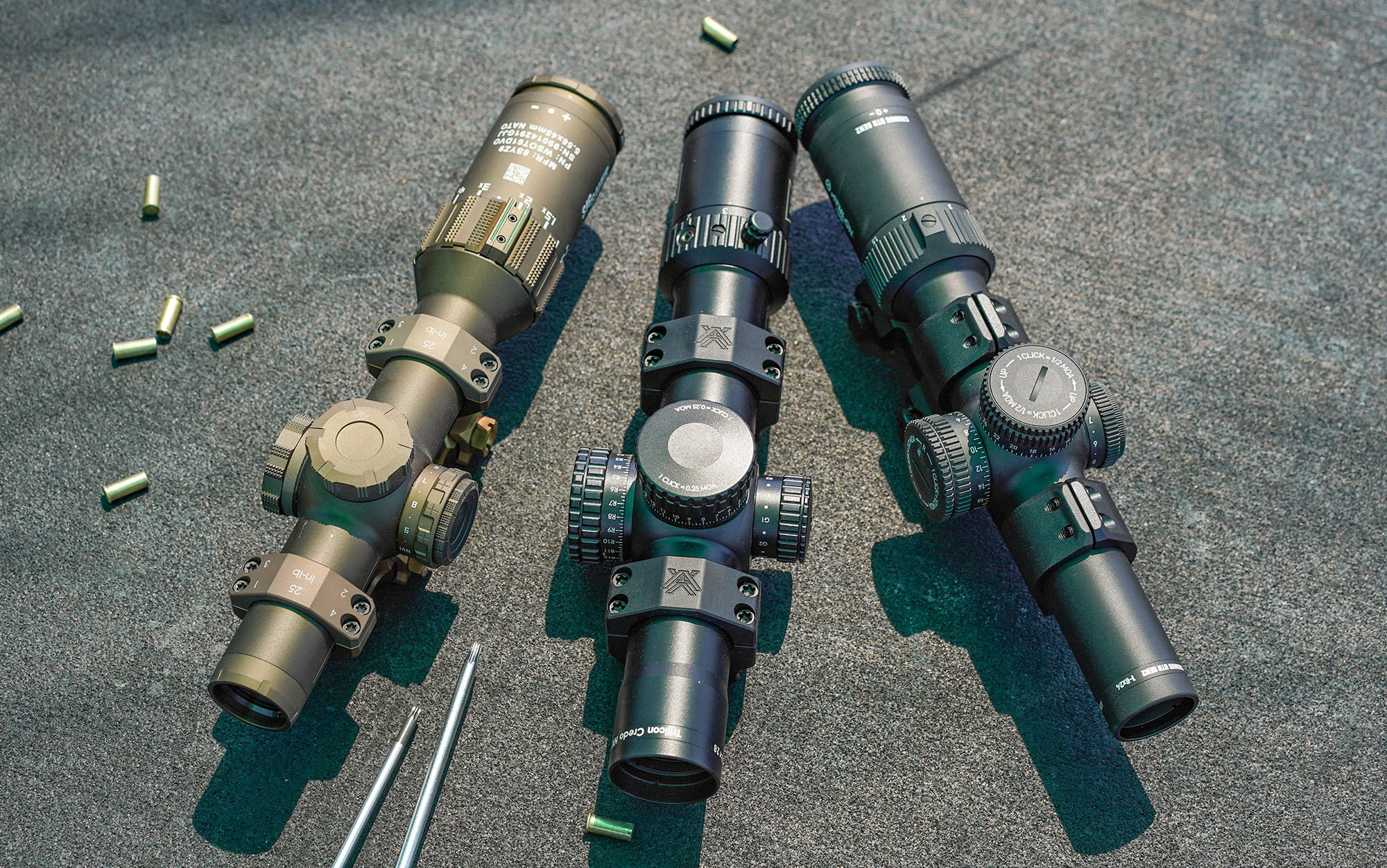
Because this is such a new and rising subset of sports optics, innovation defines the LPVO category. That dynamic alone makes this a buyers’ market. Do you want a do-it-all scope that can dominate a precision steel-target competition and then defend your homestead? Or do you want a simple, durable low-power scope that can toggle between your new 350 Legend lever gun and your turkey shotgun? This category has something for you.
Buyers are wise to look out for a few attributes. First, an unilluminated reticle on a 1-to-something-power scope is worthless. You need the aid of a bright, adjustable illuminated aiming point both in low-light conditions and in full sunlight. Second, you need a dual-purpose reticle. Here’s where the first-plane models have an advantage. They can transition from capable red-dot sights at the lowest magnifications to precision scopes at higher powers, boosting their value proposition in the process. That’s not to say second-plane reticles are useless. They are excellent choices for turkey and lever guns or for dangerous-game rifles where sure, swift, close-range shots are not only preferred, they may save your life.
One of the most surprising trends of modern sports optics is how expensive premium LPVOs have become. That may well be a function of the market; you buyers are willing to pay a kings’ ransom for these fairly niche optics. Look for the price to come down as more brands enter this space, delivering even more versatility and utility in configurations that put a premium on reticle design, illumination, and turret behavior than on glass quality.
Final Thoughts on the Best LPVO
Even more than precision snipers’ scopes, the LPVO category borrows heavily from its military genesis. Nearly half the scopes in this year’s test had their start as battle optics. That’s a helluva pedigree, but the scope that conquered Fallujah isn’t necessarily the scope that’s going to win your local 3-gun competition. Broaden your mind, cast a critical eye to what you really want an LPVO to accomplish, and then go forth and buy it. As our test confirms, there’s a lot of variety and energy in this particular segment of our shooting sports.
- Best Overall: Sig Sauer TANGO6T 1-6×24
- Best Competition: Nightforce NX8 1-8×24
- Steiner T6Xi 1-6×24
- Trijicon Credo HX 1-8×28
- Best for 3-Gun: Athlon Cronus BTR Gen2 UHD 1-6×24
- Best Dangerous Game Scope: Tract Toric UHD 1-8×24
- EOTech Vudu 1-10×28
- Best Value: Sightmark Presidio 1-6×24
- Riton 5 TACTIX 1-10×24
- Hawke Vantage 30 WA FD IR 1-8×24
